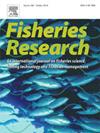Extremely slow somatic growth and intermittent recruitment of west coast steenbras Lithognathus aureti, an over-exploited, longevous Sparid, analysed with novel bootstrapped methods
IF 2.3
2区 农林科学
Q2 FISHERIES
引用次数: 0
Abstract
West coast steenbras Lithognathus aureti is an overexploited coastal Sparid in the northern Benguela ecosystem, Namibia. They are believed to consist of two genetically distinct highly resident stocks, one in northern Namibia (17–24°S) and one in southern Namibia (24–26°S). Here, Von Bertalanffy growth function (VBGF) parameters were obtained and compared using bootstrapped length-frequency-analysis, LFA (ELEFAN_GA_boot, n = 29 monthly length-frequency-distributions of 20,090 individuals), tag-and-recapture (grotag_boot, n = 80 growth increments) and length-at-age, LAA (grolenage_boot, based on n = 104 otoliths northern stock and n = 155 southern stock) methods in the “fishboot” R package. For the first time, these three methods were combined and compared within a standardized, robust bootstrap framework. The results indicated an extremely slow body growth, with similar median “optimum” results for K and L∞ , but smaller median Φ′ for LAA (otolith readings) than from other methods. LAA was the most precise method, especially when large-sized individuals were captured (northern stock). No differences in growth between stocks or sexes (males, females, hermaphrodites) were detected. The bootstrapped VBGF model that best explained the data, combining results from different methods (southern stock), had extremely slow growth with intermittent recruitment occurring every 4 years (in 2000, 2004, and 2008), with the following median values: K = 0.066 y−1 (from otoliths, 95 % CI: 0.0067–0.12 y−1), L∞ = 77.29 cm (from otoliths, 95 % CI: 55.48–400.26 cm), Φ′ = 2.62 (95 % CI: 2.52 –2.74), tanchor= 0.50 (95 % CI: 0.18–0.87), C = 0.53 (95 %CI: 0.19–0.87), and ts = 0.47 (95 %CI: 0.14–0.88) from LFA. This makes L. aureti even more vulnerable to overfishing as well as climate change. There is an urgent need for the development and application of new management strategies for this endangered, longevous species (maximum age from otolith readings: 38 years), considering its irregular reproduction, recruitment, and extremely slow growth. Also, our study evidences the need to develop new software tools for LFA, that should be able to explicitly consider intermittent recruitment.
西海岸石竹(一种过度开发的长寿蜘蛛)极其缓慢的体细胞生长和间歇性的补充,用新颖的自引导方法进行了分析
在纳米比亚本格拉北部的生态系统中,西海岸小鳞是一种被过度开发的沿海小鳞。据信它们由两个遗传上不同的高度常驻种群组成,一个在纳米比亚北部(17-24°S),另一个在纳米比亚南部(24-26°S)。本文采用引导长度-频率分析方法,对“鱼靴”R包中的LFA (ELEFAN_GA_boot, n = 29个月的长度-频率分布)、标签-捕获(grotag_boot, n = 80个生长增量)和年龄长度- LAA (grolenage_boot,基于n = 104个北方种群和n = 155个南方种群)方法进行了Von Bertalanffy生长函数(VBGF)参数的比较。这是第一次将这三种方法结合在一个标准化的、健壮的自举框架中进行比较。结果表明,体生长非常缓慢,K和L∞的中位数“最佳”结果 相似,但LAA(耳石读数)的中位数Φ '比其他方法要小。LAA是最精确的方法,特别是当捕获大型个体(北方种群)时。种群之间或性别之间(雄性、雌性、雌雄同体)的生长没有差异。最好的引导VBGF模型解释了数据,结合不同方法的结果(股票)南部,有极其缓慢的增长与间歇招聘发生每四年(2000年、2004年和2008年),用以下值中位数:K = 0.066 y−1(从耳石,95 %置信区间:0.0067—-0.12 y−1),L∞ = 77.29 厘米(从耳石,95 %置信区间:55.48—-400.26 厘米),Φ”= 2.62(95 %置信区间:2.52—-2.74),tanchor = 0.50(95 %置信区间:0.18—-0.87),C = 0.53(95 %置信区间:0.19—-0.87)和ts = 0.47(95 %置信区间:0.14-0.88)。这使得乌氏乳杆菌更容易受到过度捕捞和气候变化的影响。考虑到其不规则的繁殖、补充和极其缓慢的生长,迫切需要开发和应用新的管理策略来保护这种濒危的长寿物种(耳石数据显示的最大年龄:38岁)。此外,我们的研究证明了开发新的LFA软件工具的必要性,这些工具应该能够明确地考虑间歇性招聘。
本文章由计算机程序翻译,如有差异,请以英文原文为准。
求助全文
约1分钟内获得全文
求助全文
来源期刊

Fisheries Research
农林科学-渔业
CiteScore
4.50
自引率
16.70%
发文量
294
审稿时长
15 weeks
期刊介绍:
This journal provides an international forum for the publication of papers in the areas of fisheries science, fishing technology, fisheries management and relevant socio-economics. The scope covers fisheries in salt, brackish and freshwater systems, and all aspects of associated ecology, environmental aspects of fisheries, and economics. Both theoretical and practical papers are acceptable, including laboratory and field experimental studies relevant to fisheries. Papers on the conservation of exploitable living resources are welcome. Review and Viewpoint articles are also published. As the specified areas inevitably impinge on and interrelate with each other, the approach of the journal is multidisciplinary, and authors are encouraged to emphasise the relevance of their own work to that of other disciplines. The journal is intended for fisheries scientists, biological oceanographers, gear technologists, economists, managers, administrators, policy makers and legislators.
 求助内容:
求助内容: 应助结果提醒方式:
应助结果提醒方式:


